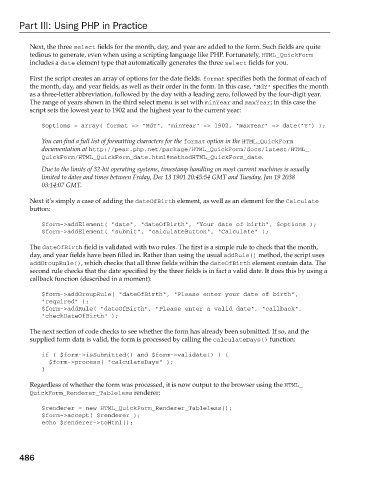Page 524 - Beginning PHP 5.3
P. 524
Part III: Using PHP in Practice
Next, the three select fields for the month, day, and year are added to the form. Such fields are quite
tedious to generate, even when using a scripting language like PHP. Fortunately, HTML_QuickForm
includes a date element type that automatically generates the three select fields for you.
First the script creates an array of options for the date fields. format specifies both the format of each of
the month, day, and year fields, as well as their order in the form. In this case, “MdY” specifies the month
as a three-letter abbreviation, followed by the day with a leading zero, followed by the four-digit year.
The range of years shown in the third select menu is set with minYear and maxYear; in this case the
script sets the lowest year to 1902 and the highest year to the current year:
$options = array( format => “MdY”, “minYear” => 1902, “maxYear” => date(“Y”) );
You can find a full list of formatting characters for the format option in the HTML_QuickForm
documentation at http://pear.php.net/package/HTML_QuickForm/docs/latest/HTML_
QuickForm/HTML_QuickForm_date.html#methodHTML_QuickForm_date.
Due to the limits of 32-bit operating systems, timestamp handling on most current machines is usually
limited to dates and times between Friday, Dec 13 1901 20:45:54 GMT and Tuesday, Jan 19 2038
03:14:07 GMT.
Next it’s simply a case of adding the dateOfBirth element, as well as an element for the Calculate
button:
$form->addElement( “date”, “dateOfBirth”, “Your date of birth”, $options );
$form->addElement( “submit”, “calculateButton”, “Calculate” );
The dateOfBirth field is validated with two rules. The first is a simple rule to check that the month,
day, and year fields have been filled in. Rather than using the usual addRule() method, the script uses
addGroupRule(), which checks that all three fields within the dateOfBirth element contain data. The
second rule checks that the date specified by the three fields is in fact a valid date. It does this by using a
callback function (described in a moment):
$form->addGroupRule( “dateOfBirth”, “Please enter your date of birth”,
“required” );
$form->addRule( “dateOfBirth”, “Please enter a valid date”, “callback”,
“checkDateOfBirth” );
The next section of code checks to see whether the form has already been submitted. If so, and the
supplied form data is valid, the form is processed by calling the calculateDays() function:
if ( $form->isSubmitted() and $form->validate() ) {
$form->process( “calculateDays” );
}
Regardless of whether the form was processed, it is now output to the browser using the HTML_
QuickForm_Renderer_Tableless renderer:
$renderer = new HTML_QuickForm_Renderer_Tableless();
$form->accept( $renderer );
echo $renderer->toHtml();
486
9/21/09 9:15:34 AM
c16.indd 486
c16.indd 486 9/21/09 9:15:34 AM

